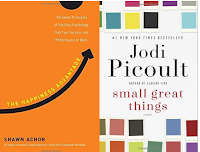Then, I saw the title of the second book and I worried: The Farmer and the Monkey.
I ordered the book the day it came out. Even though I knew the issues with anthropomorphized monkeys in children's literature, I was hopeful. Very hopeful. I trusted that maybe since this was about a circus, it would be okay. As I said, I LOVED The Farmer and the Clown and I really wanted to LOVE this one too.
I was compelled to dig a bit more. I went page by page in the book and here are some problematic things I noticed:
- The monkey appears to me to be sneaky. Before he even enters the farmer's home, he is sneaking around, climbing on the roof, peeking in windows.
- The monkey is only in the farmer's house for a few minutes before the farmer sends him away--kicks him out of the house in the dark night. Alone.
- The monkey is left alone in the night and is buried in snow while the farmer presumably sleeps peacefully, not checking on the monkey through the night.
- The next morning, the farmer sees the monkey in the snow, (seemingly waiting to be saved), feels sorry for the monkey and brings him in and cares for him. but the monkey still causes immense trouble on the farm and although the farmer doesn't seem to enjoy the monkey, he is more patient with him.
- The farmer sends the monkey off on his own to meet the train/his circus family, with a full picnic basket strapped to his back so that finally the farmer can rest peacefully on a haystack. The ending shows that the farmer's life is much better after he sends the monkey away.
- The clown visibly presents as a white child.
- When the farmer sees the clown all alone, he immediately takes him in and cares for him, holding his hand as they walk to the farmer's house. The clown seems compliant and happy to have the farmer as a friend almost immediately. This is a huge contrast from the monkey, sneaking in and causing trouble immediately and the farmer becoming flustered.
- In the home, the little clown is sweet and compliant. He does everything the farmer does.
- The farmer is so loving toward the clown that the clown sleeps in the farmer's bed while the farmer stays awake making sure the clown is comfortable. In contrast, the farmer sleeps in his own bed while the monkey sleeps on the floor in a small picnic basket, or even stays awake at night while the farmer sleeps.
- The clown was NEVER kicked out of the farmer's home. Instead the farmer did everything he could to help the clown feel welcome and to be comfortable.
- The farmer works hard to entertain the clown and to make sure he is happy. The clown also appears to be VERY helpful with chores on the farm.
- In the first book, the farmer and the clown go on a fabulous picnic using a full picnic basket as they wait for the circus train. They eat together under a tree. When the train arrives, the farmer holds the clown's hand and waits until the family comes out and greets him. The farmer and the clown have an emotional goodbye that is filled with hugs and love. The farmer seems to keep the clown's hat to remember him.
- In contrast, the monkey is sent on his own, loaded down with a heavy picnic basket that they packed with food. Instead of hugs and love, the farmer shakes the monkey's hand and sends him off, without enjoying the meal together, never making sure he gets where he is going.
- The farmer appears relieved when the monkey is gone as he rests on the haystack.
It is not my intent for this post to end up starting a conversation about this specific book, but instead for it to act as a call for all of us who work with children and children's books to commit to learning, understanding and critically analyzing books with monkeys and to understand the problematic history of these images.
I will continue to be a huge Marla Frazee fan even if I cannot be a supporter of this book. I am hoping that that authors and publishers take this issue of monkeys in picture books more seriously in the future.

















































































